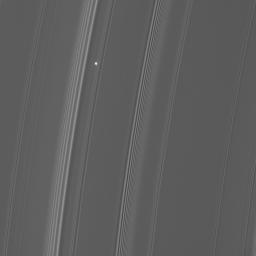
|
Flickering Aldebaran #2
- Click the image above for a larger view
- Full-Res JPEG (1008 x 1008) (42.4 kB)
- Full-Res TIFF (1008 x 1008) (1.0 MB)
Caption:
Cassini took a series of images on Sept. 9, 2006 as it watched the bright red giant star Aldebaran slip behind Saturn's rings. This type of observation is known as a stellar occultation and uses a star whose brightness is well known. As Cassini watches the rings pass in front, the star's light fluctuates, providing information about the concentrations of ring particles within the various radial features in the rings.
This view looks toward the sunlit side of the outer A ring (just interior to the Encke Gap) from about 19 degrees below the ringplane. Bright Aldebaran is over exposed, creating thin vertical lines on its image.
The image was taken in visible light with the Cassini spacecraft narrow-angle camera on Sept. 9, 2006 at a distance of approximately 358,000 kilometers (223,000 miles) from Saturn. Image scale on the sky at the distance of Saturn is 2 kilometers (1 mile) per pixel.
Background Info:
The Cassini-Huygens mission is a cooperative project of NASA, the European Space Agency and the Italian Space Agency. The Jet Propulsion Laboratory, a division of the California Institute of Technology in Pasadena, manages the mission for NASA's Science Mission Directorate, Washington, D.C. The Cassini orbiter and its two onboard cameras were designed, developed and assembled at JPL. The imaging operations center is based at the Space Science Institute in Boulder, Colo.
For more information about the Cassini-Huygens mission visit http://saturn.jpl.nasa.gov/home/index.cfm . The Cassini imaging team homepage is at http://ciclops.org .
Cataloging Keywords:
| Name | Value | Additional Values |
|---|---|---|
| Target | Saturn Rings | A Ring, Encke Gap, Saturn |
| System | Saturn | |
| Target Type | Ring | Gap, Planet |
| Mission | Cassini-Huygens | |
| Instrument Host | Cassini Orbiter | |
| Host Type | Orbiter | |
| Instrument | Imaging Science Subsystem (ISS) | |
| Detector | Narrow Angle Camera | |
| Extra Keywords | Grayscale, Occultation, Visual | |
| Acquisition Date | ||
| Release Date | 2006-10-11 | |
| Date in Caption | ||
| Image Credit | NASA/JPL/Space Science Institute | |
| Source | photojournal.jpl.nasa.gov/catalog/PIA08285 | |
| Identifier | PIA08285 | |
